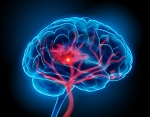
Even though today's stroke therapies can prevent major damage to the brain, eighty percent of its victims are not able to get to a hospital in time. The treatment window is within hours to twenty-four hours.
But an experimental drug extends that window to days after a stroke. In tests on mice, it was able to repair damaged brain tissue and reverse cognition, speech and motor deficits. The drug uses a technique called nonviral tissue nanotransfection which takes skin cells and reprograms their genetic code so that they create new blood vessels in damaged areas of the brain. Essentially, it's like replacing clogged pipes in your home with new ones. Blood can start flowing again to deliver oxygen to areas that lost oxygen and restore brain function.
To change skin cells into cells that will form new blood vessels, researchers introduced a special developmental gene that makes a transcription factor protein. This modifies the skin cells' genetic code and tricks them into believing they are embryonic cells whose job is to form new blood vessels. In mouse brains, these cells went to work and began forming new blood vessels.
Imagine days and maybe even weeks after a stroke being able to reverse debilitating life changing brain damage. If this cell therapy works, patients' brain cells can regenerate and possibly allow them to live their lives as they used to.
More Information
Cell Therapy Aids Stroke-Damaged Brain Repair, Restores 90% of Motor Function
Most stroke victims don't receive treatment fast enough to prevent brain damage, but scientists at the Ohio State University Wexner Medical Center, College of Engineering and College of Medicine have developed technology that can "retrain" skin cells to help repair damaged brain tissue. The nonviral tissue nanotransfection (TNT) technique effectively reprograms the skin cells to become vascular cells, which generate new blood vessels to help get blood to the damaged tissue. In tests, stroke-affected mice that received intracranial injections of the cells recovered nearly all of their motor function, and exhibited repair to damaged brain areas...
Nanotransfection-based vasculogenic cell reprogramming drives functional recovery in a mouse model of ischemic stroke
Ischemic stroke causes vascular and neuronal tissue deficiencies that could lead to substantial functional impairment and/or death. Although progenitor-based vasculogenic cell therapies have shown promise as a potential rescue strategy following ischemic stroke, current approaches face major hurdles...